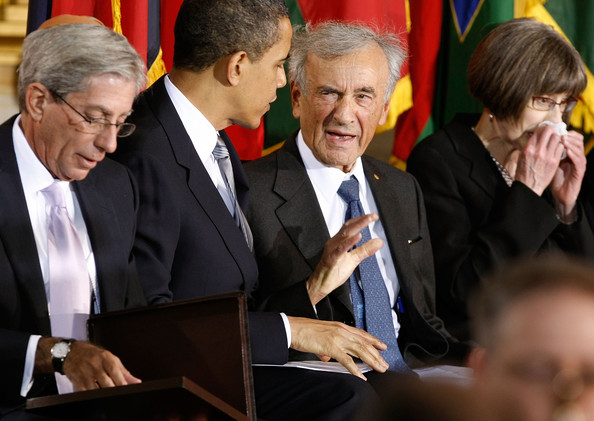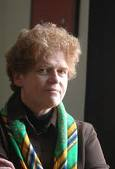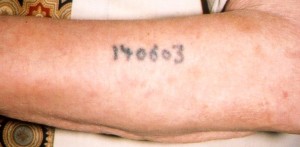Wednesday, May 11th, 2011

Above: U.S. President Barack Obama with U.S. Holocaust Memorial Council Chairman Fred Zeidman (L), Elie Wiesel (2nd from R) and Holocaust Memorial Museum Director Sara Bloomfield (R) at the “Holocaust Days Of Remembrance” ceremony in the Rotunda of the U.S. Capitol April 23, 2009 in Washington, DC. Established in 1993, the Days of Remembrance are commemorated in April so that they coincide with the observance in Israel. (Photo by Chip Somodevilla/Getty Images)
By Carolyn Yeager
It has just been announced that Elie Wiesel will be the recipient of the FIRST U.S. Holocaust Memorial Museum Award. Not a surprise. Wiesel is the one upon whom the “Holocaust Industry” feels safe in heaping praise, therefore he has enough “distinguished service” type awards to wallpaper a room.
What has he done to actually deserve them? He has been in the service of the outlaw state of Israel for most of his long life, condoning the dispossession of the native Palestinian people, and even their destruction by napalm bombing and massacres carried out on a regular basis. He’s not really a very good liar, although a prolific one, and so his self-created life story is not convincing to a mind that has even a little bit of critical capacity.
If we search earnestly for what this man has actually accomplished, we find a mixture of self-promotion and Holocaust “memory” promotion. In other words, Wiesel is a promoter. He’s made his name synonomous with The Holocaust. Of course, he’s been helped in this by powerful organizations, not least of which is the New York Times Corporation. That is a story that is yet to be told on this website, but it has been well-explored by Prof. David O’Connell in his article “Elie Wiesel and the Catholics.”
Wiesel’s so-called “humanitarian work” has been directed almost exclusively to help Jews and Jewish causes. He makes statements now and then about other groups, such as Africans in Darfur, but mostly ignores all those who are currently in distress in the world today in favor of receiving large sums of money to speak about the Jewish past. He will be doing the same when he receives the award from the USHMM on May 16 – an award that may very well have a sum of money attached to it. Money, by the way, that will be coming from the pockets of U.S. taxpayers!
 Instead of celebrating this whole hypocritical affair, we should be sickened by it. According to USHMM director Sara Bloomfield, right, (see Bradley Smith’s youtube conversation with Sara), who will present the award, “no one else has done so much (as Wiesel) to honor the victims of the Holocaust by working tirelessly to create a more just world in their memory.” Hmmm. Once again, a more just world for Jews. She explains he does this by his “conviction that the Museum should be a ‘living’ memorial.” She doesn’t explain what makes it ‘living’ and don’t expect her to. These are just words that are designed to stir emotions or good feelings in the hearer, and is what they expect. By such words we are to accept that “His legacy to humanity is unique and extraordinary.” Just don’t ask questions.
Instead of celebrating this whole hypocritical affair, we should be sickened by it. According to USHMM director Sara Bloomfield, right, (see Bradley Smith’s youtube conversation with Sara), who will present the award, “no one else has done so much (as Wiesel) to honor the victims of the Holocaust by working tirelessly to create a more just world in their memory.” Hmmm. Once again, a more just world for Jews. She explains he does this by his “conviction that the Museum should be a ‘living’ memorial.” She doesn’t explain what makes it ‘living’ and don’t expect her to. These are just words that are designed to stir emotions or good feelings in the hearer, and is what they expect. By such words we are to accept that “His legacy to humanity is unique and extraordinary.” Just don’t ask questions.
 Those lucky enough to attend this dinner will also be able to hear Deborah Lipstadt, left, who will give a speech to promote her new book The Eichmann Trial. In fact, this year of 2011 was picked for the first award because it is the 65th anniversary of the verdicts at the first Nuremberg trial and the 50th anniversary of the trial of Adolf Eichmann. They can’t let “memory” die out, you know. And there is also that need to mark anniversaries of the most sacred dates in the Holocaust religious calendar.
Those lucky enough to attend this dinner will also be able to hear Deborah Lipstadt, left, who will give a speech to promote her new book The Eichmann Trial. In fact, this year of 2011 was picked for the first award because it is the 65th anniversary of the verdicts at the first Nuremberg trial and the 50th anniversary of the trial of Adolf Eichmann. They can’t let “memory” die out, you know. And there is also that need to mark anniversaries of the most sacred dates in the Holocaust religious calendar.
P.S. A postscript to Seven-up: Here is your chance to leaflet a Wiesel event in person. Hop on a plane and get yourself to the Wardman Park Marriott Hotel in Wash. D.C. by May 16th and you’ve got it made. Remember, you can download leaflets questioning Wiesel’s tattoo by clicking on the Downloads button on our menu bar—if you don’t have any leaflets of your own. Good luck and let us know how it went.
9 Comments
Category Featured | Tags: Tags: Barack Obama, Deborah Lipstadt, Elie Wiesel, Sara Bloomfield, United States Holocaust Memorial Museum,
Social Networks: Facebook, Twitter, Google Bookmarks, del.icio.us, StumbleUpon, Digg, Reddit, Posterous.
Sunday, May 1st, 2011
by Carolyn Yeager
Today, May 1st, Elie Wiesel Cons The World received the 17th comment on the blogpost “Is Elie Wiesel a perjurer?” This is the most comments for any article posted here except for our very first “Welcome” blog .
Six ‘believers’ were disturbed enough by this article to write a comment scolding us for it. This tells me that the idea that Elie Wiesel does not have a tattoo, yet says he does, is the most worrisome issue for believers. They get angry when faced with the proof that Elie Wiesel tells lies. They have no way to talk around it.
Realizing this, I am re-posting that article with some added material which I have put in brackets []. This version of the article should be circulated as widely as possible to the mainstream media and mainstream commentators by those of you who want to see some action on this.
Written on August 24, 2010 at 10:01 am, by Carolyn Yeager
Elie Wiesel stated under oath while giving testimony in the trial of Eric Hunt in San Francisco, California in July 2008 that the number A7713 was tattooed on his left arm. (see Where is the Tattoo?)
Wiesel should have been asked to show his tattoo to the court at that time, but he wasn’t. This was a failure of the defense, for sure. But obviously, at that time, Mr. Hunt, the defendant, was not questioning whether Elie Wiesel had been an inmate of Auschwitz-Birkenau.
Since then, Mr. Hunt and others have uncovered video photography of Wiesel’s bare left arm from all angles, leaving no reasonable doubt that no tattoo is there. Backing up this conclusion is the fact that Wiesel has also famously refused to ever show his tattoo when requested to do so. For those who will retaliate that Wiesel may have had the tattoo removed, he said as late as March 25, 2010 that he still had the number A7713 on his arm. (see Where is the Tattoo?) [In September or October 2012, AP reporter Verena Dobnik wrote in a published news report that Elie Wiesel showed her his tattoo during an interview. Wiesel has never denied the story.]
From this, the average man on the street would probably agree that Elie Wiesel has committed perjury (a criminal offense) if he does not indeed have the number tattooed on his arm. The law, according to http://www.lectlaw.com/def2/p032.htm, says:
When a person, having taken an oath before a competent tribunal, officer, or person, in any case in which a law of the U.S. authorizes an oath to be administered, that he will testify, declare, depose, or certify truly, or that any written testimony, declaration, deposition, or certificate by him subscribed, is true, willfully and contrary to such oath states or subscribes any material matter which he does not believe to be true; or in any declaration, certificate, verification, or statement under penalty of perjury, willfully subscribes as true any material matter which he does not believe to be true; (18 USC )
In order for a person to be found guilty of perjury the government must prove: the person testified under oath before [e.g., the grand jury]; at least one particular statement was false; and the person knew at the time the testimony was false.
[Under the law, Elie Wiesel did knowingly lie to the court about a tattoo on his arm.] However, in practice, the question of materiality is crucial. Perjury is defined at www.criminal-law.freeadvice.com as:
the “willful and corrupt taking of a false oath in regard to a material matter in a judicial proceeding.” It is sometimes called “lying under oath;” that is, deliberately telling a lie in a courtroom proceeding after having taken an oath to tell the truth. It is important that the false statement be material to the case at hand—that it could affect the outcome of the case. It is not considered perjury, for example, to lie about your age, unless your age is a key factor in proving the case.
So the question becomes: Was the status of Elie Wiesel as a survivor of at least a seven-month incarceration at Auschwitz-Birkenau in 1944-45, in which case he would certainly have been tattooed on his left arm, as he states himself, material to the guilt or innocence of Eric Hunt in light of the charges that had been brought against him? Certainly, Eric Hunt, not long out of college at the time and who had been assigned to read Night in school, had come to doubt the truth of Wiesel’s assertions and descriptions in the book, and believed that if he could confront Wiesel alone, unguarded, he could convince him to tell the truth.
Does the suspicion that Wiesel necessarily lied in his book Night about what he saw and experienced at Auschwitz-Birkenau because he lied about the existence of a tattoo which he has always claimed as proof of his credentials as an Auschwitz survivor, exonerate Eric Hunt from some of the charges brought against him by the State of California? Is it material to the case? Perhaps not, but it does show cause for Eric Hunt’s desire to speak to Elie Wiesel in an unguarded moment, which was what he was attempting to do.
[I have changed my mind about this materiality issue. Whether Wiesel has a tattoo or doesn’t is very “material” to whether his “protected status” as a holocaust survivior gives him the right to avoid questions by the public, such as Eric Hunt was seeking to ask. Wiesel admits he was not harmed in any way by Hunt, but only frightened for a moment — this hardly warrants a charge of kidnapping against Hunt, or for Hunt to be found guilty of “assault”, and even more, of being guilty of a “hate crime,” which is a felony. Without the “hate crime” attachment, Hunt would not now be burdened with the legal status of felon.
If Elie Wiesel is lying about having a tattoo from Auschwitz on his arm, it is Elie Wiesel who is guilty of spreading hate (against Germans collectively, and yes, against Eric Hunt), and has been doing so since 1960 when his book Night was first published. Eric Hunt was therefore trying to stop the hate by trying to get the truth out of Elie Wiesel.]
If Elie Wiesel cannot be legally found guilty of perjury because of questions of materiality, he will certainly be guilty of perjury in the eyes of the public if he does not produce the famous tattoo A-7713 on his arm—the sooner the better. We are waiting, Mr. Wiesel.
Watch a new, short video on the subject.
Addendum:

”Auschwitz survivor Sam Rosenzweig displays his identification tattoo.” From Wikipedia According to the information below, this man was in the “regular” series—numbers not preceeded with a letter of the alphabet. Note also that the tattoo is on the outside of the left forearm.
This is the best looking tattoo I could find on the Internet. If you want to have your faith in the Auschwitz Holocaust story badly shaken, google “Auschwitz tattoos” (or any variation thereof) – Images, and see what comes up. Frightening! Of the little that is there, most look like the numbers are way too big, and you find the same few people exhibiting their specimen.
[It should be noted that Auschwitz-Birkenau was the ONLY camp that tattooed its inmates. It was a decision by the camp authorities, not by the SS hierarchy or Adolf Hitler. It probaby came about because of the large number of inmates at Auschwitz-Birkenau-Monowitz and their tendency to give false names and trade places with one another.]
However … George Rosenthal, Trenton, NJ, an Auschwitz Survivor, has written an “authoritative” account at Jewish Virtual Library based on “documents” obtained from The United States Holocaust Memorial Museum. (Sorry, no pictures here either, or on the USHMM website. Elie Wiesel was a major driving force in the creationof the USHMM; why didn’t he volunteer his tattoo to be pictured on their website as an example of what a genuine tattoo looks like? Why does the USHMM have no images of a tattoo?)
Mr. Rosenthal writes:
The sequence according to which serial numbers were issued evolved over time. The numbering scheme was divided into “regular,” AU, Z, EH, A, and B series’. The “regular” series consisted of a consecutive numerical series that was used, in the early phase of the Auschwitz concentration camp, to identify Poles, Jews, and most other prisoners (all male). This series was used from May 1940-January 1945, although the population that it identified evolved over time. Following the introduction of other categories of prisoners into the camp, the numbering scheme became more complex. The “AU” series denoted Soviet prisoners of war, while the “Z” series (with the “Z” standing for the German word for Gypsy, Zigeuner) designated the Romany. These identifying letters preceded the tattooed serial numbers after they were instituted. “EH” designated prisoners that had been sent for “reeducation” (Erziehungshäftlinge).
In May 1944, numbers in the “A” series and the “B” series were first issued to Jewish prisoners, beginning with the men on May 13th and the women on May 16th. The “A” series was to be completed with 20,000; however an error led to the women being numbered to 25,378 before the “B” series was begun. The intention was to work through the entire alphabet with 20,000 numbers being issued in each letter series. In each series, men and women had their own separate numerical series, ostensibly beginning with number 1.
According to this, since there was never a “C” series, the maximum number of prisoners that could have been tattooed after May 1944 was 45,378.
Under “Notes” at the bottom of the page, four books are listed, all by holocaust historians. Are these the “documents” referred to? It also says Source: Center for Holocaust and Genocide Studies at the very bottom of the page, as if referring to the entire page. This Center is located at the University of Minnesota. The affiliated faculty reveals mostly Jewish names.
I report all this because I’m looking for authoritative sources for the exact placement of the tattoos on the left arm, but one doesn’t find that answer even at the Auschwitz-Birkenau Memorial Museum. Why all the uncertainty? Could it be because so many pseudo-survivors have tattooed themselves in unusual ways and places, and the authorities don’t want to nullify their legitimacy?
19 Comments
Category Featured | Tags: Tags: Auschwitz tattoos, Elie Wiesel, Eric Hunt, George Rosenthal, perjury,
Social Networks: Facebook, Twitter, Google Bookmarks, del.icio.us, StumbleUpon, Digg, Reddit, Posterous.
 Instead of celebrating this whole hypocritical affair, we should be sickened by it. According to USHMM director Sara Bloomfield, right, (see Bradley Smith’s youtube conversation with Sara), who will present the award, “no one else has done so much (as Wiesel) to honor the victims of the Holocaust by working tirelessly to create a more just world in their memory.” Hmmm. Once again, a more just world for Jews. She explains he does this by his “conviction that the Museum should be a ‘living’ memorial.” She doesn’t explain what makes it ‘living’ and don’t expect her to. These are just words that are designed to stir emotions or good feelings in the hearer, and is what they expect. By such words we are to accept that “His legacy to humanity is unique and extraordinary.” Just don’t ask questions.
Instead of celebrating this whole hypocritical affair, we should be sickened by it. According to USHMM director Sara Bloomfield, right, (see Bradley Smith’s youtube conversation with Sara), who will present the award, “no one else has done so much (as Wiesel) to honor the victims of the Holocaust by working tirelessly to create a more just world in their memory.” Hmmm. Once again, a more just world for Jews. She explains he does this by his “conviction that the Museum should be a ‘living’ memorial.” She doesn’t explain what makes it ‘living’ and don’t expect her to. These are just words that are designed to stir emotions or good feelings in the hearer, and is what they expect. By such words we are to accept that “His legacy to humanity is unique and extraordinary.” Just don’t ask questions. Those lucky enough to attend this dinner will also be able to hear Deborah Lipstadt, left, who will give a speech to promote her new book The Eichmann Trial. In fact, this year of 2011 was picked for the first award because it is the 65th anniversary of the verdicts at the first Nuremberg trial and the 50th anniversary of the trial of Adolf Eichmann. They can’t let “memory” die out, you know. And there is also that need to mark anniversaries of the most sacred dates in the Holocaust religious calendar.
Those lucky enough to attend this dinner will also be able to hear Deborah Lipstadt, left, who will give a speech to promote her new book The Eichmann Trial. In fact, this year of 2011 was picked for the first award because it is the 65th anniversary of the verdicts at the first Nuremberg trial and the 50th anniversary of the trial of Adolf Eichmann. They can’t let “memory” die out, you know. And there is also that need to mark anniversaries of the most sacred dates in the Holocaust religious calendar.


